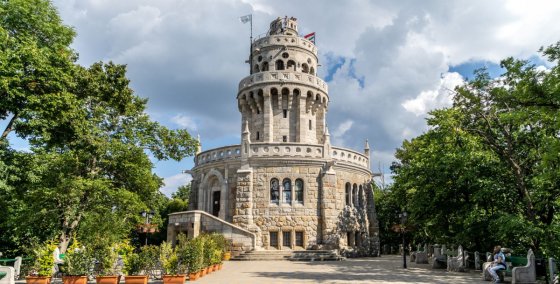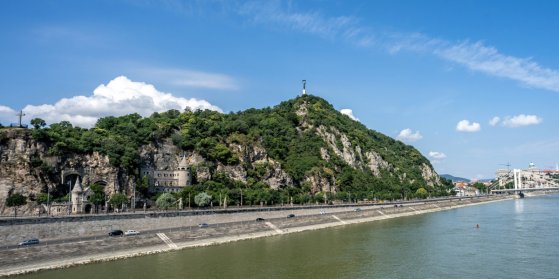 The „intertwined history” of the bridges and the city of Budapest
Which ideas and events have shaped the fate of bridges of Budapest and the cityscape? Alongside many other interesting facts, this question is also answered this newly published book by the Budapest City Archives, which introduces the history of bridges in Budapest.
The „intertwined history” of the bridges and the city of Budapest
Which ideas and events have shaped the fate of bridges of Budapest and the cityscape? Alongside many other interesting facts, this question is also answered this newly published book by the Budapest City Archives, which introduces the history of bridges in Budapest.
Heritage
 Water meters were installed 100 years ago to reduce water waste
Water meters were installed 100 years ago to reduce water waste
August 25, 2020 at 1:00 PM
It is hard to imagine today that drinking water from the tap was not always a basic service. Mihály Kajlinger, born 160 years ago, has indisputable merit in the organisation and construction of Budapest's water supply. His name is associated with the plans for the capital's large sewage pumping station, sewerage, and water supply network, but water consumption meters were also introduced at his suggestion to curb water waste. His main work, the waterworks of Káposztásmegyer, was the most beautiful and modern waterworks in contemporary Europe.
New Drug Research Centre to open next year in former hospital building
August 24, 2020 at 9:00 AM
The capital has few hospital buildings opened more than a hundred years ago that do not need to be thoroughly renovated, remodelled or modernised. There was also a period, not so long ago, when such institutions were closed rather than maintained. But the list of empty unused buildings also goes on and on, as they await new use of demolition. Fortunately, there are already examples of healthcare buildings being renovated without major changes in function. An example is the former Schöpf-Merei Ágoston Hospital.
The bells of Saint Stephen's Basilica – Hungarian and German masterpieces
August 21, 2020 at 9:00 AM
The historical value of the former and present bells in Saint Stephen's Basilica in Budapest is significant in terms of ecclesiastical, industrial and national history. Today’s large bell was donated by the German people in 1990 and was made by Perner in Passau. The bell was consecrated on 20 August 1990, thirty years ago. It is the largest bell in Hungary today.
Statue of Saint Emeric unveiled 90 years ago – Despite several plans, the memorial was never moved
August 16, 2020 at 10:00 AM
The statue of Saint Emeric erected in 1930 has survived the storms of history. Later it survived the battles of 1956 and the attacks of the socialist ideology untouched. Although its demolition was raised several times, the statue by Zsigmond Kisfaludi Strobl still stands where it was unveiled 90 years ago, as part of the events commemorating the 900th anniversary of Saint Emeric's death.
A footprint of Budapest – Stunning paving stones hide in old building around Budapest
August 15, 2020 at 10:00 AM
How many times have we been told to watch out steps? The saying can be useful when walking the streets of Budapest near open doorways because the capital's architecture is more than the facades facing the street! Entering through the gates, we drop into a closed world, where those paying attention will discover many beautiful details. The most colourful of these, in addition to painted glass windows, are floor pavings.
Breathtaking panorama for high-altitude bathing – The forgotten memories of swimming on Svábhegy
August 11, 2020 at 1:00 PM
At the time of its construction, the Svábhegy open-air pool was characterised as an “artistic and significant work for tourism” at the opening in July 1934. The former spa, located at 430 metres above sea level, designed by our legendary athlete and architect, Alfréd Hajós, deserved the attributes above with its beautiful geographical location and cleverly solved architectural realisation.
The lid of a Venetian cure-all and a medieval staircase have been unearthed in the newest cultural area in Buda Castle
August 7, 2020 at 11:00 AM
The outdoor site of 9 Táncsics Street has been reborn as the T9 - The First Bastion archaeological exhibition and cultural community space. The former József Barracks and Prison building is continuously revealing the layers of its history. During the current archaeological excavation, the remains of a medieval and Ottoman building that used to stand here have emerged from under the floor of the house.
Lajos Batthyány's public reburial took place 150 years ago – The 42-year-old Prime Ministers was buried in secret after being executed
August 5, 2020 at 1:00 PM
The execution of Count Lajos Batthyány, the first elected Hungarian prime minister, remains an indescribable act of retaliation after the war of independence. The prime minister was buried in secret and then reburied publicly 21 years later, in 1870, with great pomp. The nation laid him to rest in a funeral fitting the difficult diplomatic solution worthy of a great politician.
The highest point of Budapest – Elizabeth Lookout turns 110
August 2, 2020 at 3:00 PM
One of Sisi's favourite places to visit in Budapest. The highest point of the city houses one of Budapest's most popular lookout towers, the Elizabeth Lookout. The building, designed by Pál Kluzinger and Frigyes Schulek, was opened 110 years ago. Pestbuda climbed János Hill to honour the anniversary.
A neglected landmark – A walk on Gellért Hill
August 1, 2020 at 1:30 PM
Despite it being a symbol of Budapest, a popular walking destination, and a nature reserve in the city's heart, Gellért Hill has been neglected for decades. Unfortunately, the situation is beyond slight renovation – a complete replanning and reconstruction are needed.
The memory of János Bihari on Margit Island
July 26, 2020 at 3:00 PM
The history of an old statue on Margit Island hides many interesting things. How many people know today that the traditional symbol of the gipsies was a hedgehog? This symbol was included on János Bihari's, one of the most loved gipsy musicians dubbed the Gypsy King, statue on the Margit Island, created by a special figure of Hungarian statuary, the deaf-mute László Vaszary.
The Székely national anthem was first played in Budapest – Memorial plaque unveiled on the lyricist's home
July 19, 2020 at 3:00 PM
While many Hungarians know the lyrics to the Székely national anthem, while the work written soon after the Treaty of Trianon was signed quickly became symbolic of Hungarian unity, few know the name of the writer who originally wrote the lyrics: György Csanády. To honour the writer's memory, born 125 years ago, a memorial plaque has been unveiled on the 12th-district house he lived in.
Béla IV, died 750 years ago, founded Buda but does not even have a memorial plaque in the Castle District
July 6, 2020 at 8:00 AM
After the Tartar invasion, King Béla IV founded the city that is known today as Buda. He was looking for a place that would be impregnable during a next Mongol attack. He surrounded the plateau of Castle Hill with thick walls, parcelled and populated the area, and built monasteries and churches. Béla IV's Buda still exists today, the castle walls he built, the streets he walked on, the house walls and window frames he could see, the booths he could sit in, but not even a plaque preserves the name of the founder here.
The Budapest Dream – A Footbridge over the Danube
July 2, 2020 at 6:00 PM
Many people believe that the Chain Bridge could be the footbridge of the future. However, the bridge was not designed to be one. It consists of three well-separated sections: the two footpaths and the road section. There is no way to move between the sections, and the view from the middle is lacklustre due to the nature of the design. Another solution is the only way forward to create a footbridge that so many in Budapest have wanted for years.
Poetry Day Walk - Statues of the greatest Hungarian poets in Budapest
April 11, 2020 at 10:00 PM
On this year's National Poetry Day, 11 April - the birthday of Attila József - the public, community poem readings, which have already become a tradition, were cancelled, and we could not even visit the statues of the greatest Hungarian poets to show our respect and gratitude. Thus, Pestbuda offers only a virtual walk between the works depicting our national greats in Budapest.
More articles
 The „intertwined history” of the bridges and the city of Budapest
Which ideas and events have shaped the fate of bridges of Budapest and the cityscape? Alongside many other interesting facts, this question is also answered this newly published book by the Budapest City Archives, which introduces the history of bridges in Budapest.
The „intertwined history” of the bridges and the city of Budapest
Which ideas and events have shaped the fate of bridges of Budapest and the cityscape? Alongside many other interesting facts, this question is also answered this newly published book by the Budapest City Archives, which introduces the history of bridges in Budapest.
 The Bridge Report, which brought a turning point in the history of Budapest
A travel report that changed the history of Pest and Buda, as well as Hungary. The little book contributed to the change of half a thousand years of legal customs and the implementation of an investment of unprecedented size and technical quality. This book was The Bridge Report [Hídjelentés in Hungarian].
The Bridge Report, which brought a turning point in the history of Budapest
A travel report that changed the history of Pest and Buda, as well as Hungary. The little book contributed to the change of half a thousand years of legal customs and the implementation of an investment of unprecedented size and technical quality. This book was The Bridge Report [Hídjelentés in Hungarian].
 Drama on the university wall - The heroic monument was planned 95 years ago
In the constant hustle and bustle of the Egyetem Square in Pest, the students may not even notice the monument that decorates the short section of wall between the church and the central building of ELTE. However, it commemorates their predecessors, the heroes who fought for their country in World War I, and those who heroically helped them. The first design of the dramatically collapsing soldier was born in 1928, ninety-five years ago.
Drama on the university wall - The heroic monument was planned 95 years ago
In the constant hustle and bustle of the Egyetem Square in Pest, the students may not even notice the monument that decorates the short section of wall between the church and the central building of ELTE. However, it commemorates their predecessors, the heroes who fought for their country in World War I, and those who heroically helped them. The first design of the dramatically collapsing soldier was born in 1928, ninety-five years ago.














